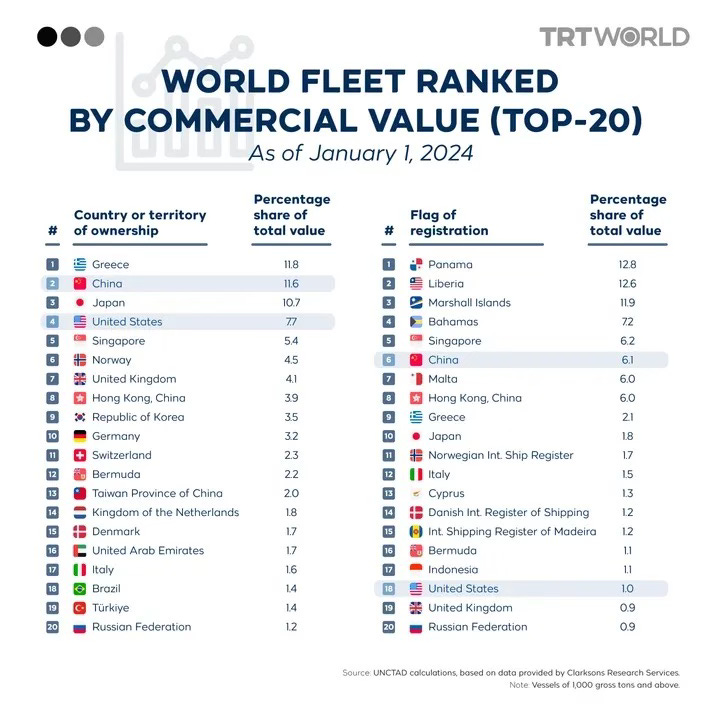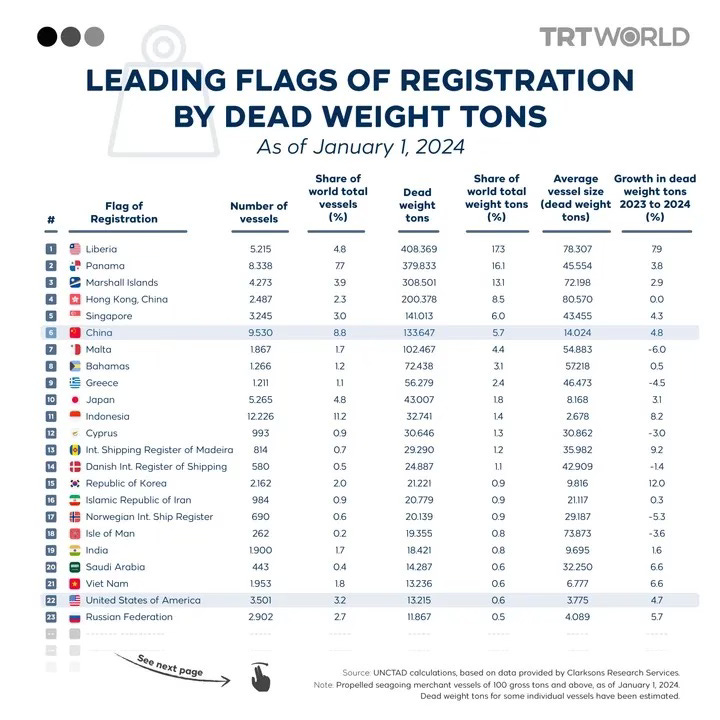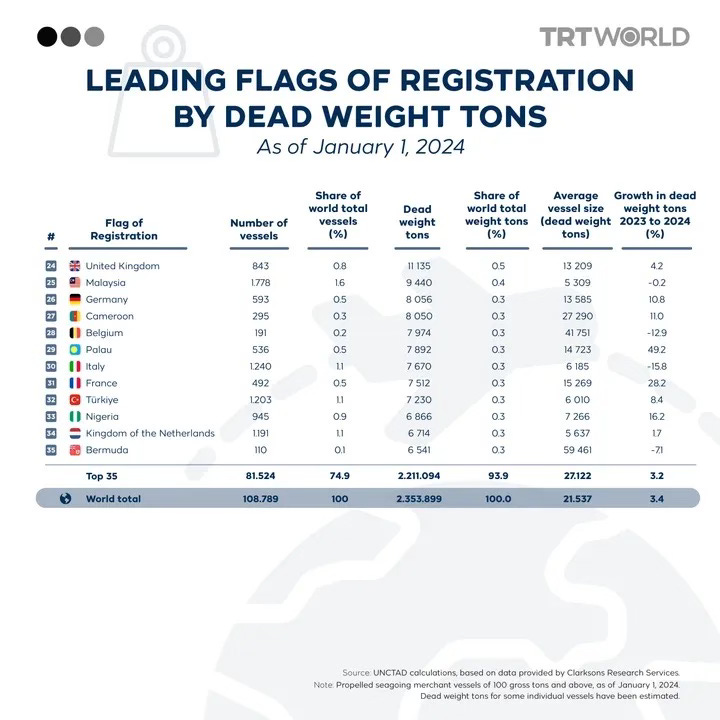Shipping Tug of War: Part 2 of 3
Can the US revive its shipbuilding industry by targeting China’s dominance?
Can the US revive its shipbuilding industry by targeting China’s dominance?
Trump’s new maritime push, marked by port fees on Chinese-built vessels, seeks to revive America’s shipbuilding industry and curb Beijing’s dominance—but critics warn it’s more politics than policy, with global trade implications.
By
In a sweeping move aimed at restoring the United States' maritime strength, the Donald Trump administration has announced a series of aggressive policies targeting China’s dominance in the shipbuilding, logistics, and maritime sectors.
On Thursday, the US Trade Representative (USTR) unveiled a revised plan to impose port fees on Chinese-built vessels, modifying anearlier proposal in February that had suggested charges of up to $1.5 million per port call. Though scaled back, the new phased approach—starting October 14, 2025—still marks a significant shift, sending shockwaves across the global shipping industry. Fees will increase gradually over three years.
While the US administration claims that the policy is intended to curb China’s dominance in global shipbuilding, reinvigorate the ailing US shipyard sector, and bolster national economic security, critics and industry insiders say the move appears more symbolic than strategic.
Tom Christopher Tong, founder and export director of Executive Exports based in Guangzhou, called the US plan “an outright silly concept,” describing it as “a political stunt aimed at stirring emotional appeal rather than solving structural industrial gaps.”
While acknowledging that a modest revival of America’s maritime sector might be feasible, Tong insists that reversing China’s dominance is a fantasy. “It’s a dream—completely unrealistic,” he told TRT World. “Why would such a reversal even be necessary in the first place?”
China currently builds approximately 51 percent of the world’s commercial ships, with South Korea and Japan accounting for another 44 percent.
China on Friday condemned the United States over its newly imposed port fees, warning that the measures would ultimately harm American consumers and destabilise global trade.
Industry experts and trade associations also warn that the plan could backfire—raising consumer prices, disrupting freight logistics, and burdening American exporters with more expensive and complicated port calls.
Following intense industry backlash and warnings of higher costs cascading through global supply chains, the US significantly watered down its original proposal. Exemptions now apply to ships on US domestic routes, the Caribbean, US territories, and Great Lakes ports. US-based carriers such as Matson and Seaboard Marine, along with foreign ships arriving empty to load US exports, will also avoid the charges.
“Each exemption only highlights the weakness of a certain area and its dependence on Chinese-dominated shipping services,” Tong said, noting that the US is trying to send a signal of strength but has ended up “undermining itself by exposing its biggest weaknesses.”
An ambitious but improbable vision
The port fees are just one component of Trump’s broader Maritime Executive Order signed on April 9, 2025. The order outlines a multi-agency effort to rebuild America’s maritime industrial base and make US-built and -flagged vessels competitive again.
Measures include financial incentives, deregulation, workforce development, and the creation of maritime prosperity zones. The order also empowers the USTR to impose tariffs and service fees on Chinese-built ships and equipment such as container vessels and ship-to-shore cranes.
Yet many view the plan as an attempt to reclaim lost ground in an industry where the US has long lagged behind.
According to the latest data from United Nations Conference on Trade and Development (UNCTAD), China currently builds approximately 51 percent of the world’s commercial ships, with South Korea and Japan accounting for another 44 percent. The US, by comparison, builds less than 0.5 percent of the world's ships annually—about five commercial vessels per year.
Chinese shipyards produce over 1,700 vessels annually. In contrast, US shipyards cater primarily to military contracts, with little capacity or competitive edge in global commercial markets.
"Trying to catch up to China in commercial shipbuilding is like entering a Formula 1 race with a bicycle," said one maritime economist who declined to be named. "The capital investment, skilled labour, and technological ecosystem required is massive, and we are decades behind."
Tong underscored how futile the goal of reversing dominance really is. While he acknowledged a “short-term chilling effect” on China-US exports, he believed the long-term competitiveness of Chinese shipbuilders would remain unaffected. “These fees hinder cost effectiveness but do not inherently reduce the strength and value provided by Chinese shipbuilders.”
Potential supply chain disruption
About 80 percent of global trade moves via ocean freight. Imposing new fees and restrictions on this system, especially on the world's dominant fleet—which includes thousands of China-built vessels—risks creating bottlenecks and supply chain instability.
Furthermore, the global shipping industry is integrated and interdependent. Many US-based firms, like Seaboard Marine and Matson, rely on Chinese-built ships. While the USTR’s exemptions provide short-term relief, there remains widespread uncertainty over the long-term implications.
The American Apparel & Footwear Association (AAFA) warned that the cumulative effect of port fees and tariffs on cargo-handling equipment could reduce trade and raise prices for American consumers.
“We are deeply concerned that the newly announced port fees and shipping mandates are destined to have devastating consequences for American workers, consumers, and exporters,” AAFA said in anofficial statement.
Tong noted that Chinese firms are already adapting to the evolving US policy landscape. “China’s shipping industry is reducing US-bound booking volumes, raising sea freight rates, and revising trade contract terms to safeguard their interests,” he said, warning that these adjustments could undermine the viability of certain trade flows and potentially trigger a diversion of trade to countries like Vietnam.
Geopolitical storms
Some observers contend that the Maritime Executive Order is less about reviving US shipbuilding and more about increasing leverage over Beijing ahead of a potential new round of trade negotiations.
The phased implementation of fees, multiple carve-outs, and long-term targets stretching over decades suggest that immediate industrial revival is not the primary objective. Instead, analysts argue these measures are part of a broader geopolitical strategy aimed at containing China’s rise and extracting trade concessions.
Trump’s maritime strategy reflects a broader protectionist turn in US economic policy, reminiscent of the early 20th century when the Jones Act (1920), which aimed to shield US shipping from foreign competition. However, in an era defined by globalisation, digital trade, and transnational supply chains, such protectionist policies may yield diminishing returns.
“Might this be yet another policy that Trump intends to withdraw once the mere threat has served its desired purpose in pressuring his international counterpart?” asked Tong. “We will soon find out.”
As the international shipping community continues to respond and China mulls its countermeasures, one thing is clear: the seas may be calm now, but geopolitical storms are brewing.
https://trt.global/world/article/325e781ee5b9
China’s shipbuilding dominance poses economic and national security risks for the U.S., a report says
WASHINGTON--In only two decades, China has grown to be the dominant player in shipbuilding, claiming more than half of the world’s commercial shipbuilding market, while the U.S. share has fallen to just 0.1%, posing serious economic and national security challenges for the U.S. and its allies, according to a report released Tuesday by the Center for Strategic and International Studies.
In 2024 alone, one Chinese shipbuilder constructed more commercial vessels by tonnage than the entire U.S. shipbuilding industry has built since the end of World War II. China already has the world’s largest naval fleet, the Washington-based bipartisan think tank said in its 75-page report.
“The erosion of U.S. and allied shipbuilding capabilities poses an urgent threat to military readiness, reduces economic opportunities, and contributes to China’s global power-projection ambitions,” the report said.
Concerns about the poor state of U.S. shipbuilding have been growing in recent years, as the country faces rising challenges from China, which has the world’s second largest economy and has ambitions to reshape the world order. At a congressional hearing in December, senior officials and lawmakers urged action.
Last week, President Donald Trump told Congress that his Republican administration would “resurrect” the American shipbuilding industry, for commercial and military vessels, and he would create “a new office of shipbuilding in the White House.”
“We used to make so many ships,” Trump said. “We don’t make them anymore very much, but we’re going to make them very fast, very soon. It will have a huge impact.”
In February, the heads of four major labor unions called on Trump to boost American shipbuilding and enforce tariffs and other “strong penalties” against China for its increasing dominance in that sector.
“What we are seeing now is a recognition of the strategic significance of shipbuilding and port security, and the related challenges posed by China,” said Matthew Funaiole, a senior fellow in the China Power Project at CSIS and a co-author of the report. Funaiole said concerns over shipbuilding are “a fairly bipartisan issue.”
The report said that China’s shipbuilding sector went through “a striking metamorphosis” in the past two decades, transforming from a “peripheral player” to the dominant player on the global market, with efforts centered on one state-owned enterprise: China State Shipbuilding Corporation, or CSSC.
At the same time, China has greatly expanded its navy. Last year, a CSIS assessment found that China was operating 234 warships, compared with the U.S. Navy’s 219, although the U.S. continued to hold an advantage in guided missile cruisers and destroyers.
In developing recommendations for the U.S. to compete with China, the researchers zoomed in on the Chinese company’s use of Beijing’s “military-civil fusion” strategy, which blurs the lines between the country’s defense and commercial sectors.
They found that CSSC, which builds both commercial and military ships, sells three-quarters of its commercial production to buyers outside China, including to the U.S.-allied Denmark, France, Greece, Japan and South Korea. These foreign firms are thus funneling billions of dollars to Chinese shipyards that also make warships, advancing China’s modernization of its navy and providing Chinese defense contractors with key dual-use technology, the report said.
The CSIS researchers suggested that, as a long-term fix, the U.S. should invest in rebuilding its shipbuilding industry and work with allies to expand shipbuilding capacities outside China. For the near term, they recommended actions to level the playing field and “disrupt China’s murky dual-use ecosystem,” such as by charging docking fees on Chinese-made vessels and cutting U.S. financial and business ties with CSSC and its subsidiaries.
The Trump administration has proposed new fees on China-linked vessels calling on U.S. ports. A BlackRock-led consortium last week agreed to acquire stakes in 43 ports across the globe, including the two ports on either side of the Panama Canal, from a Hong Kong-based conglomerate.
NB: U.S. to levy fees on ships linked to China, push allies to do similar – draft executive order.










